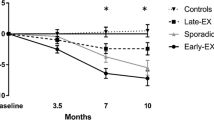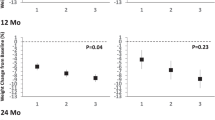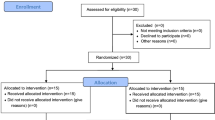Abstract
OBJECTIVE: Exercise is the cornerstone of behavioral weight loss programs. The total volume of exercise needed to both promote weight loss and elicit health benefits has not been sufficiently investigated. The aim of this study was to examine the effects of two different volumes of walking ‘metabolic fitness’ exercise prescriptions, in combination with a low-fat, ad libitum diet (LFAL) on weight loss and additional modifiable health-related variables (HRV) in an ethnically diverse sample of overweight premenopausal women.
DESIGN: Clinical 12 week weight loss intervention study with a 5.0–5.8 MJ diet daily with (a) participants walking 30 min, 5 days per week (DEX1), (b) participants walking 60 min, five times per week (DEX2) or (c) a diet only control group (DO).
SUBJECTS: A mixed racial sample (predominantly Hispanic) of 56 subjects (mean BMI=34.26±6.61, mean age= 39.45±7.34) completed the 12 week program.
MEASUREMENTS: Various body weight, body composition and fat distribution variables, dietary intake and additional HRV such as blood lipids, blood pressure and an estimate of cardiorespiratory fitness at baseline and after 3 months.
RESULTS: All groups showed similar and significant (P<0.001) declines in body weight, percentage body fat, BMI, WHR, fat mass, fat-free mass and diastolic blood pressure following the program. In addition, total cholesterol, triacylglycerol and the TC:HDL ratio displayed a significant time effect (P<0.05). Significant interactions (P<0.05) were found for waist circumference, sagittal diameter, estimated VO2max and LDL-C, with both exercise groups showing similar and significantly greater (P<0.05) improvements than DO. Significant interactions (P<0.05) were also observed for several dietary variables.
CONCLUSION: Our study showed no dose–response effect of walking exercise on weight loss over diet alone. Both lower and higher volume metabolic fitness prescriptions resulted in similar and significant beneficial changes in several HRV. This data suggests that 30 min of walking on most days of the week may be as beneficial as 60 min (in combination with diet) in promoting numerous additional healthful outcomes over diet alone following a 12 week weight loss program.
This is a preview of subscription content, access via your institution
Access options
Subscribe to this journal
Receive 12 print issues and online access
$259.00 per year
only $21.58 per issue
Buy this article
- Purchase on Springer Link
- Instant access to full article PDF
Prices may be subject to local taxes which are calculated during checkout

Similar content being viewed by others
References
Must A, Spadano J, Coakley EH, Field AE, Colditz G, Dietz WH . The disease burden associated with overweight and obesity JAMA 1999 282: 1523–1529.
Manson JE, Willett WC, Stampfer MJ et al. Body weight and mortality among women New Engl J Med 1995 333: 677–685.
Després J-P, Lamarche B . Effects of diet and physical activity on adiposity and body fat distribution: implications for the prevention of cardiovascular disease Nutr Res Rev 1993 6: 137–159.
Weinsier RL, Wadden TA, Ritenbaugh C, Harrison GG, Johnson S, Wilmore JH . Recommended therapeutic guidelines for professional weight control programs Am J Clin Nutr 1984 40: 865–872.
National Heart, Lung and Blood Institute. Clinical guidelines on the identification, evaluation, and treatment of overweight and obesity in adults National Institutes of Health: Bethesda, MD 1998.
Hill JO, Drougas H, Peters JC . Obesity treatment: can diet composition play a role? Ann Intern Med 1993 119: 694–697.
Després J-P . Visceral obesity, insulin resistance, and dyslipidemia: contribution of endurance exercise training to the treatment of the plurimetabolic syndrome Exerc Sport Sci Rev 1997 25: 271–300.
Després J-P, Lamarche B . Low-intensity endurance exercise training, plasma lipoproteins and the risk of coronary heart disease J Intern Med 1994 236: 7–22.
Haskell WL . Health consequences of physical activity: understanding and challenges regarding dose-response Med Sci Sports Exerc 1994 26: 649–660.
Oja P . Dose response between total volume of physical activity and health and fitness Med Sci Sports Exerc 2001 33: S428–S437.
Williamson DF . Descriptive epidemiology of body weight and weight change in U.S. adults Ann Intern Med 1993 119: 646–649.
United States Census Bureau. 2000.
Siri WE . The gross composition of the body In: Lawrence JH, Tobias CA (eds) Advances in biological and medical physics Academic Press: New York 1956 pp 239–280.
Evans PE, Israel RG, Flickinger EG, O'Brien KF, Donnelly JE . Hydrostatic weighing without head submersion in morbidly obese females Am J Clin Nutr 1989 50: 400–403.
Perry AC, Applegate EB, Jackson ML, Deprima S, Goldberg RB, Ross R, Kempner L, Feldman BB . Racial differences in visceral adipose tissue but not anthropometric markers of health-related variables J Appl Physiol 2000 89: 636–643.
Kline GM, Porcari JP, Hintermeister R et al. Estimation of VO2max from a one-mile track walk, gender, age, and body weight Med Sci Sports Exerc 1987 19: 253–259.
Friedewald WT, Levy RI, Friedriksen DS . Estimation of the concentration of LDL cholesterol in plasma without the use of preparative ultracentriguation Clin Chem 1972 18: 499–502.
Stampfer MJ, Sacks FM, Salvini S, Willett WC, Hennekens CH . A prospective study of cholesterol apolipoproteins, and the risk of myocardial infaction New Engl J Med 1991 325: 373–381.
American Dietetic Association and American Diabetes Association. Exchange lists for weight management American Diabetes Association: Chicago, IL 1989.
Foreyt JP, Goodrick GK . Health maintenance through exercise and nutrition In: Blechman EA (ed) Behavior modification with women Guilford: New York 1984 pp 221–244.
US Surgeon General. Physical activity and health: a report of the Surgeon General S/N 017-023-00196-5 US Department of Health and Human Services, Centers for Disease Control and Prevention, National Center for Chronic Disease Prevention and Health Promotion: Atlanta, GA 1996.
National Institutes of Health Consensus Statement. Physical activity and cardiovascular health, NIH Consensus Statement National Institutes of Health: Bethesda, MD 1995 13: pp. 1–33.
Pate RR, Pratt M, Blair SN, Haskell WL, Macera CA, Bouchard C . Physical activity and public health: a recommendation from the Centers for Disease Control and Prevention and the American College of Sports Medicine JAMA 1995 273: 402–407.
Ballor DL, Poehlman ET . Exercise-training enhances fat-free mass preservation during diet-induced weight loss: a meta-analytical finding Int J Obes Relat Metab Disord 1994 18: 35–40.
Health Canada and Canadian Society for Exercise Physiology. Handbook for Canada's physical activity guide to healthy active living Health Canada: Ontario 1998.
Duncan JJ, Gordon NF, Scott CB . Women walking for health and fitness JAMA 1991 266: 3295–3299.
Sweeney ME, Hill JO, Heller PA, Baney R, DiGirolamo M . Severe vs. moderate energy restriction with and without exercise in the treatment of obesity: efficiency of weight loss Am J Clin Nutr 1993 57: 127–134.
Stefanick ML . Physical activity for preventing and treating obesity-related dyslipoproteinemias Med Sci Sports Exerc 1999 31: S609–S618.
Wing RR . Physical activity in the treatment of the adulthood overweight and obesity; current evidence and research issues Med Sci Sports Exerc 1999 31: S547–S552.
Schlundt DG, Hill JO, Pope-Cordle J, Arnold D, Virts KL, Katahn M . Randomized evaluation of a low fat ad libitum carbohydrate diet for weight reduction Int J Obes 1993 17: 623–629.
Hammer RL, Barrier CA, Roundy ES, Bradford JM, Fisher AG . Calorie-restricted low fat diet and exercise in obese women Am J Clin Nutr 1989 49: 77–85.
Forbes GB, Brown MR, Welle SL, Lipinski BA . Deliberate overfeeding in women and men: energy cost and composition of the weight gain Br J Nutr 1986 56: 1–9.
Kraemer WJ, Volek JS, Clark KL et al. Physiological adaptations to a weight-loss dietary regimen and exercise programs in women J Appl Physiol 1997 83: 270–279.
Ross R, Rissanen J . Mobilization of visceral and subcutaneous adipose tissue in response to energy restriction and exercise Am J Clin Nutr 1994 60: 695–703.
Jakicic JM, Wing RR . Differences in resting energy expenditure in African-American vs Caucasian overweight females Int J Obes Relat Metab Disord 1998 22: 236–242.
Weinseir RL, Hunter GR, Gower BA, Schutz Y, Darnell BE, Zuckerman PA . Body fat distribution in white and black women: different patterns of intraabdominal and subcutaneous abdominal adipose tissue utilization with weight loss Am J Clin Nutr 2001 74: 631–636.
Glass JN, Miller WC, Szymanski LM, Fernhall B, Durstine JL . Physiological responses to weight-loss intervention in inactive obese African-American and Caucasian women J Sport Med Phys Fit 2002 42: 56–64.
Kannel WB, Cupples LA, Ramaswami R, Stokes J, Kreger BE, Higgins M . Regional obesity and risk of cardiovascular disease; the Framingham study J Clin Epidemiol 1991 44: 183–190.
Baum CL, Brown M . Low-fat, high carbohydrate diets and atherogenic risk Nutr Rev 2000 58: 148–151.
Stefanick ML, Mackey S, Sheehan M, Ellsworth N, Haskell WL, Wood PD . Effects of diet and exercise in men and postmenopausal women with low levels of HDL cholesterol and high levels of LDL cholesterol New Engl J Med 1998 339: 12–20.
Andersen RE, Wadden TA, Bartlett SJ, Vogt A, Weinstock RS . Relation of weight loss to changes in serum lipids and lipoproteins in obese women Am J Clin Nutr 1995 62: 350–357.
Brown SA, Norris J, Torgan C, Duscha BD, Bales C, Slentz CA, Kraus WE . Effects of moderate exercise training in the absence of weight loss on cardiovascular risk factors in mildly obese subjects Clin Exercise Physiol 2000 2: 27–33.
Wei M, Kampert JB, Barlow CE, Nichaman MZ, Gibbons LW, Paffenbarger RS, Blair SN . Relationship between low cardiorespiratory fitness and mortality in normal-weight, overweight, and obese men JAMA 1999 282: 1547–1555.
Ludwig DS, Pereira MA, Kroenke CH, Hilner JE, Van Horn L, Slattery ML, Jacobs DR . Dietary fiber, weight gain and cardiovascular disease risk factors in young adults JAMA 1999 282: 1539–1546.
King NA, Tremblay A, Blundell JE . Effects of exercise on appetite control: implications for energy balance Med Sci Sports Exerc 1997 29: 1076–1089.
Tremblay A, Drapeau V . Physical activity and preference for selected macronutrients Med Sci Sports Exerc 1999 31: S584–S589.
Jakicic JM, Winters C, Wei Lang, Wing RR . Effects of intermittent exercise and use of home exercise equipment on adherence, weight loss, and fitness in overweight women JAMA 1999 282: 1554–1560.
Wing RR, Hill JO . Successful weight loss maintenance A Rev Nutr 2001 21: 323–341.
Author information
Authors and Affiliations
Corresponding author
Rights and permissions
About this article
Cite this article
Bond Brill, J., Perry, A., Parker, L. et al. Dose–response effect of walking exercise on weight loss. How much is enough?. Int J Obes 26, 1484–1493 (2002). https://doi.org/10.1038/sj.ijo.0802133
Received:
Revised:
Accepted:
Published:
Issue Date:
DOI: https://doi.org/10.1038/sj.ijo.0802133
Keywords
This article is cited by
-
Quantifying the Effects of Different Treadmill Training Speeds and Durations on the Health of Rat Knee Joints
Sports Medicine - Open (2018)
-
Associations between physical activity and BMI, body fatness, and visceral adiposity in overweight or obese Latino and non-Latino adults
International Journal of Obesity (2017)
-
Weight Loss Strategies for Obese Adults: Personalized Weight Management Program vs. Standard Care
Obesity (2006)



